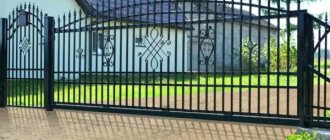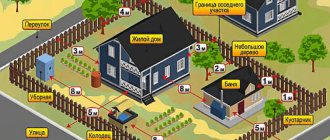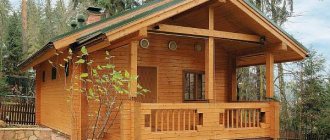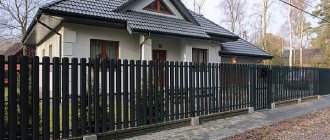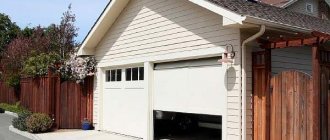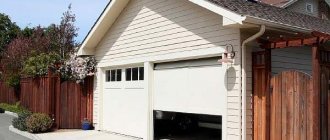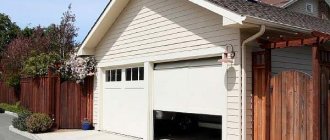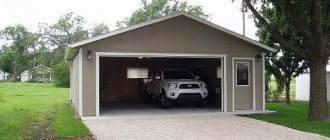Sometimes disagreements arise between people living nearby, which can escalate into a serious conflict and lead to litigation. Often the cause of the dispute is the incorrect location of the outhouse toilet. There is a special set of rules that indicate at what distance a toilet can be built from the fence of a neighboring site.
Problems with neighbors
Today, owners of neighboring houses most often quarrel for several reasons:
- high fence height;
- encroachment of a fence onto someone else’s property;
- darkening of the neighboring area.
Many summer residents sort things out because of the distance between sanitary facilities and their fence. Such buildings include:
- well;
- toilet;
- sauna;
- bathhouse
In order to maintain normal relations and not bring the matter to court, before building a toilet, it is worth discussing the plans with the owners of neighboring plots. It would be helpful to have their written consent to build a toilet near the fence. The most important thing is to comply with all laws and regulations for the construction of a structure.
What are the consequences of failure to comply with building layout standards?
The law obliges the owner to eliminate violations. Tall trees need to be cut down, light sheds and gazebos need to be moved. If a house is built with violations, then inspection organizations can impose a fine and force the cottage to be demolished. It is almost impossible to legitimize the violation legally. It is precisely because of problems with registration that it is better to start construction by contacting a design organization, which will develop a project based on the location, taking into account the characteristics of a specific territory.
Make an appointment with an architect
Established standards
There is a set of rules developed by the Ministry of Regional Development of the Russian Federation. They clearly indicate the features of planning and development of the territories of dacha associations of citizens. According to these rules, the distance from the fence to the toilet should not be less than one meter. In this case, the slope from the roof cannot be oriented towards someone else’s site. Also, when installing a toilet, the distance to residential buildings and wells is taken into account. It is necessary to place it at the dacha so that the well or well is at least twelve meters away. Close proximity threatens contamination of drinking water. This can happen due to harmful microbes entering the well. When digging a cesspool, the type of soil and the location of groundwater are taken into account. Usually the toilet is placed at a distance of 1–3 meters from the neighbor’s fence, with the condition that there is no drinking source nearby. Also, the rules for maintaining sanitary conditions indicate other minimum distances to the fence:
- from a residential building - three meters; /
- from bushes - one meter;
- from the trunks of tall trees - four meters.
There are laws relating to new buildings. First of all, they call for common sense, but SNiP precisely indicates all the parameters.
Rules and regulations
In the era of state standardization, SNiPs were developed: documents regulating the correct conduct of construction and the distance between constructed buildings. In a more recent period, there was an urgent need for the existence of such standards that could be oriented towards. That is why they returned to everyday reality:
- GOST standards in relation to the building materials used and production processes;
- SanPiN aimed at preventing bacterial and parasitic infection, the danger of poisoning drinking water and soil used for growing vegetables;
- construction standards determined by the need to comply with fire safety, namely: prevention of fire, sparks and smoke, depending on the building materials;
- distance standards, non-compliance with which entails a violation of the owner’s right to use the property, guaranteed by the legislation of the Russian Federation;
- Town Planning Code and Code of Administrative Offences;
- acts on the procedure for land management and development adopted by local and regional authorities.
The distance from the shed to the neighbors’ fence, as well as the standards for the demarcating structure itself, was additionally stipulated in SNiP 30-02-97, as amended in 2021. The right planning solution allows you to operate your property without any problems.
The distance to the fence, the construction of which is the responsibility of the owner of the land plot and demarcates his property from that of others, is his responsibility by law. At the border (interface), determined by the relevant cadastral companies and confirmed by documents on the right of ownership, its plot ends.
It is where someone else’s property begins, which the other owner has the right to use according to his own needs. However, the norms of removal from it are observed bilaterally so that the rights of neither one nor the other owner are violated.
What is SNiP 30-02-97 and SP 53.13330.2011?
Legislative norms, which must be strictly followed, determine any distance on small plots of private property. When deciding at what distance from the fence a barn, bathhouse, residential building or toilet can be built, any owner must take into account not only his own interests. By complying with the requirements of regulatory documents, he ensures the legal rights of another person, so he may well expect the same law-abiding behavior from his neighbor.
The existing rules can only help avoid possible claims and complaints filed with local governments or the board of SNT and dacha cooperatives.
Following them makes it possible to avoid quarrels and assault, filing lawsuits, conducting expensive examinations or demolishing buildings that should not stand in their existing form according to the law. The document, known firsthand to developers as SNiP 30-02-97*, is the main document that legally regulates all standards for design and development on the territory of the Russian Federation.
Transformed into SP 53.13330.2011, it carries the standards for the development of individual housing construction, summer cottages, cooperatives and horticultural non-profit partnerships (SNT). But this is not its only function. This regulatory code is the basis for the development of territorial building codes.
Basic norms and rules for development on SNT and individual housing construction sites
Building codes, which have been edited several times, including in 2021, can provide information on the following parameters:
- Distances permissible under living conditions relative to the neighbor's fence. This includes the distance from the fence to the barn, which is defined as 1 meter for an outbuilding used for storing equipment. The standard of 4 meters is accepted as the minimum distance for a building that houses a chicken coop or small livestock. This also includes 3 m from a residential building on a garden plot, a distance from other buildings of 1 meter and the distance for planting trees, which depends on their growth, - 2 and 4 m.
- Fire safety, at the very minimum permissible distance, which depends on the building materials used, their ability to ignite and resistance. It is also very important to take certain actions to prevent danger.
- The document pays special attention to the removal of sanitary and hygienic structures (toilets, wells, drinking water wells, baths and saunas) from neighboring fences. Sanitary standards are also taken into account, dictating how to place others from buildings of this kind, what distances to maintain in order to avoid infections, contamination and contamination. According to the new edition, adopted as a legislative document, a distance of at least 12 m from a residential building, cellar and latrine must be at least 12 m from a barn containing poultry or livestock. If the outbuilding is located under the same roof as the house, a distance of at least 12 m is required between the entrances. 7 m.
All these standards are presented below in diagrams and pictures.
Where to contact
If your dacha neighbors violated the rules and placed the toilet closer to the fence than they should, you can appeal the installation. Perhaps it will be possible to reach an agreement peacefully. Otherwise, you need to write a complaint to the local authorities, who will conduct an inspection. The current rules will help eliminate conflicts with other summer residents and avoid penalties from the State Fire Supervision Authority and Technical Supervision. Failure to comply with SNiP requirements leads to legal proceedings. The court decision is usually made in favor of the plaintiff, and the defendant is punished by a fine and dismantling of the toilet. In some cases, plots of land are too small, their area does not allow the placement of buildings in accordance with established standards. Then it’s worth using the services of BTI employees who will explain all the nuances. It is better to prevent the possibility of conflicts and take the design of buildings seriously. When calculating the distances from structures to the fence, you should be guided by accepted standards. Just think, who would enjoy the proximity of someone else's toilet to their home? Moreover, if right next to the fence there is a children’s corner or a well-groomed beautiful place that can be seen from the windows. Therefore, it is worth agreeing with the owner of the neighboring property at what distance from the fence the toilet will be located.
In the process of arranging the territory of a private plot, the owners of a summer cottage have many questions. Including the question of what distance should be from the septic tank to the fence. Of course, this nuance will not interest people who are building a private house as a permanent residence. In such cases, the owners decide to build a toilet inside the structure in order to comfortably use it at any time of the year. Therefore, this issue is important for those who are building a septic tank on the street.
Site plan with distances from the neighbors' fence to the toilet and other buildings
Conditions established by law that are binding
To avoid getting into such situations, every owner of a piece of land needs to know and comply with legal requirements, regulations and restrictions.
There are clear standards that are established by the state in the regulatory document DBN 79-92 “Residential buildings for individual developers in Ukraine.” The following distances are established for green spaces:
- 5 m for trees and 1.5 m for bushes from the wall of the building;
- 1 m for bushes and 3 m for trees from the border of the land plot.
It was agreed that the branches should not be located so as to cross the boundaries of neighboring territories. If this happens, then the neighbor will have every right to cut off the branches or roots of the tree that have penetrated his territory and become an obstacle to the use of the land.
Based on DBN 360-92 “Urban planning. Planning and development of urban and rural settlements” the distance to the border from the wall should be at least 1 m, provided that there is no building on the other side. A condition has been stipulated for the mandatory construction of engineering structures that will prevent the flow of water from the roofs and eaves of the structure onto the adjacent territory belonging to the neighbor.
According to sanitary standards, the location of the toilet should be no closer than 15 m from the dwelling or summer kitchen. The well with drinking water should be located at least 20 m away from the toilet.
The fence must be placed strictly along the border of the plots, and it should not interfere with the use of the neighboring territory for its intended purpose. Local councils set requirements regarding the design, height and material of fencing for land plots.
Land owners are required to choose options for using their territory in accordance with its intended purpose. In addition, the fact of the least inconvenience caused to neighbors is taken into account. Namely: unpleasant odors, noise, smoke or darkness. These issues today do not belong to the central government, but are within the competence of local governments.
Standards are established by local development rules, as well as by the improvement project of the city and other populated areas, which are approved by local councils and agreed upon by the local architecture and urban planning authority. However, it should be said that the norms of the DBN are fully reflected in the acts approved by the local government bodies.
Important nuances
- All requirements regarding how far the toilet should be from the fence are regulated in SNiP, and are also specified in acts of land management organizations and rural or city government bodies.
- The established rules should be strictly adhered to, because violation is fraught with administrative penalties in the form of fines in the amount established by the administrative code. In addition, a toilet placed incorrectly on the premises may be ordered to be demolished and moved to another location. And this, accordingly, additional financial expenses.
- It is worth approaching this issue responsibly so as not to disrupt relations with the people of the neighboring area. From both a moral and administrative point of view, it is better to live together.
Distance from the toilet to outbuildings on the site
After all, today you will cause them discomfort with foreign odors from the septic tank, and tomorrow they can build a stable or install a greenhouse right under your fence. Therefore, this fact must be taken into account.
- It is necessary to calculate the distance from the fence to the toilet at the stage of planning the equipment of the land space, so as not to encounter problems and litigation at the moment when all the structures have already been erected and equipped.
It is important to consider all of the above factors in order to remain a good neighbor and citizen, acting in accordance with established legal requirements.
Regulatory documents and requirements
To determine the status of the greenhouse and its development category, you should be guided by the requirements of SNiP 2.07.01-89*.
It classifies a polycarbonate structure as an outbuilding, and a film structure as a temporary structure without a foundation. The distance from a greenhouse of any type to a fence, house and other buildings is regulated by SP 42.13330.2011 “Urban planning. Planning and development of urban and rural settlements" and allows you to install a greenhouse:
- from the fence, the border of the neighboring plot and trees - 1 meter;
- from your own and your neighbor’s residential building – 3 meters;
- from the red line on a summer cottage - 5 meters;
- from outbuildings in SNT or individual housing construction - 1 meter.
If there are no other buildings nearby, then the distance from the fence to the greenhouse is determined to be 1 meter. This also corresponds to the standard distance from the fence to the toilet. In other cases, it must be installed by carefully measuring the distance to the foundation of the neighbor’s house or the red line - the place where underground and overhead communications are laid, and the border of the site.
The second parameter regulating the location of the greenhouse is the possibility of shadow falling on the neighboring garden. On the other side of the fence there should not be a piece of land that is in the shadow of a warm garden during daylight hours. In this case, you need to install the greenhouse further from the neighbor’s fence or make it lower.
In accordance with fire safety regulations, there must be free passage around a structure that does not pose a fire hazard. A distance of 1 m to the fence fully ensures this condition if the passage is cleared and not planted with bushes.
The last condition, based on the requirements of SNiP 21-01–97*, concerns waste and rainwater. They should not end up on land occupied by neighbors. The distance to the fence is determined by the roof structure and the slope of the ground.
If the adjacent plot is empty
The land owner who develops first has a number of advantages. He needs to install any fence exactly along the demarcation line and retreat 3 meters from it when building a house. When constructing a garage and other outbuildings, it will be enough to retreat exactly a meter. A neighbor building later will have to comply with additional standards, in addition to 1 m from the border:
- 5–10 m from the house depending on the wall material;
- 5 m from the garage;
- 3 m from the greenhouse.
The distance from the fence of 1 m can only be increased to meet other requirements of SNiP 21-01–97*.
Red line and side street
The red line defines the boundaries of the area ahead. Communications are usually laid along it along the street. The front fence can be placed directly along the line. The greenhouse and all other buildings must retreat 5 m from it.
When the dacha has an alley on the side, the greenhouse should be placed at a distance of 3 m from the fence if its location coincides with the border of the road. When the fence is moved into the yard, it is necessary to maintain 1 m from the fence and 3 m from the border of the road and the pedestrian sidewalk in the alley. In any case, the distance from the fence to the road must be maintained initially.
Return to contents
Questions with neighbors
A toilet placed at the wrong distance from a neighbor's fence can cause a surge of negative emotions in people living nearby. Sometimes conflicts can be resolved mutually, and sometimes it comes to lawsuits, which, as a rule, end not in favor of the offender.
Distances from buildings on the site to neighbors
It is the construction of a septic tank on a site close to a neighbor’s site that becomes the most common problem in court proceedings.
To avoid such ups and downs, you should familiarize yourself with the set of rules, which indicate what distance from the neighbor’s fence to the toilet is permissible and possible. In addition to the fact that you should understand the rules and the distance should be strictly observed, you should:
- Discuss your plans regarding the placement of the toilet with the residents of the area near whose fence the construction of a sanitary unit is planned;
- It would be very appropriate to obtain written consent for the construction of a toilet in the decided location from the residents of the neighboring plot. This way they will not be able to make claims in the future. However, if the norms and requirements for the minimum distance from the toilet to the neighbors’ fence are violated and the residents of a nearby plot sell the plot, then the new owners may well make claims.
Permission from neighbors to build a fence
By adhering to simple methods and the requirements of SNiP, the owners of the allotment will never encounter problems regarding the placement of a toilet close to the neighbor’s fence.
Rules for measuring distance
For plots, the minimum size is fixed at the legislative level - 4 acres. A smaller plot of land is not subject to state registration. Hence, in the future there may be problems with the sale or donation of land. The distance between buildings on adjacent sites will be calculated not only based on standards, but also taking into account the architecture of the buildings. You will have to take into account all the protruding parts of the building - the canopy, basement, bay window and even the porch. This rule applies to those buildings whose projections are more than 50 cm from the main wall of the building.
Standards for installing a toilet on the site
There are rules that have been developed by the Ministry of Regional Development.
These rules clearly and clearly indicate all the nuances of planning, as well as the development of land plots that are privately owned.
The above set of rules clearly describes at what distance a septic tank can be placed from the neighbors’ fence. The rules are:
- The toilet should be no closer than one meter from the neighbor’s fence.
- The roof slope should be directed towards the plot owners' plot, and not be visible when neighbors are working on the garden plot.
Layout of the toilet on the site
- In addition to the distance of the toilet in the country house not far from the neighbor’s fence, when installing the structure, you also need to take into account where the well is located for the owners and neighbors. The distance must be at least 12 meters from the well so as not to compromise the purity and safety of drinking water.
- Also, the toilet should not be located closer than three meters from a residential building on a neighboring property.
Compliance with all the above standards will ensure a quiet life for the owners of the plot, and will also allow them to maintain normal friendly relations with their neighbors.
People who neglect the requirements and rules for equipping a plot of land may face a lot of troubles, ranging from conflicts with neighbors to protracted court proceedings. Therefore, it is better to protect yourself from such difficulties, because they are easy to avoid. In order not to run into problems and not become a violator, you should carefully prepare for the development of the territory by studying the rules,
requirements for installing a fence between neighbors
.
The placement of objects in private buildings is regulated by many documents
One of the key issues that needs to be addressed at the site planning stage is the distance between the fence and the building located closest. Moreover, the task is simple only at first glance, since the location of buildings and the type of fence directly affect the interests of the owners of the neighboring plot.
It is for this reason that in design work it is necessary to be guided not by abstract ideas about a sufficient distance from the border between land plots, but by the norms set out in the relevant permitting documents. Where to find these norms, how to interpret them, and what to do in different situations - we will talk about all this in the article.
Boundary marks and indentations
A boundary sign is a physical designation of the boundaries of a site . The owner is obliged to install them when starting construction, so that other persons can see how the site is located on the ground and do not violate the rights of the owner by their actions.
Signs are divided by type:
- A metal pipe up to 105 cm long, which is buried in the ground to a depth of at least 80 cm. This is a long-term boundary sign;
- A wooden stake of the same height is installed for medium periods;
- A short-term boundary sign is a metal mark on which a plate with information is installed
A boundary sign marks the actual boundary of the site. When it is established, the cadastral engineer issues a land surveying act, which graphically indicates the boundaries of the land plot.
Usually the location of the building is determined based on this act and the cadastral plan of the land plot. Then engineers take measurements on the ground and mark the foundation.
Simply measuring 3 m from the boundary sign is an unprofitable way to determine the location of the building, since the border of the land plot may be an uneven line , and violations of the setback requirements are possible.
Site layout
Fundamentals of regulatory settlement
In the vast majority of cases, rather narrow questions are discussed on specialized forums, such as “How many meters from the fence can you build a bathhouse?” or “What distance from the fence to the trees can be considered acceptable?” We will try to bring all the information into a single system and create a kind of guide to the standards. It will help you if you do the planning yourself, without contacting design organizations.
Checking the distance
Distances between various objects in private development are regulated by two main documents. This:
- Construction norms and rules (SNiP) 30-02-97, which regulate the procedure for planning and effective development of gardening associations and other private properties.
- Construction standard SP 11-106-97, which describes the procedure for creating design documentation for the development of private property, and also regulates its approval and coordination with licensing authorities.
Distance between houses
The first thing these regulatory documents pay attention to is the distances between the buildings themselves. According to current fire safety standards, houses on private property cannot be built close to each other, regardless of the distance from the fence to the building. This is due to the fact that if a fire occurs, not only the ignited building, but also those adjacent to it may burn out.
From this point of view, the following standards are relevant:
- If the building is made of completely non-combustible materials (stone, brick, concrete), then it is necessary to maintain a distance of 6 meters from the same building, from a building with wooden floors protected by metal tiles or corrugated sheets - 8 meters, and from a wooden house - 10.
- A house made of non-flammable material with a roof on wooden rafters protected by low-flammable material is built 8 meters from the same houses or houses with less flammability, and at least 10 meters from wooden houses.
- The most difficult thing is with wooden buildings or houses on a wooden frame. Even if the building is treated with fire retardants, the distance from such a house to the neighboring one is within 10-15 meters, depending on the design features of the house built by the neighbor.
Two-row building scheme
Note! In case of two-row development of private households, it is allowed to erect two residential or commercial buildings side by side. This planning technique is called blocking and does not contradict current fire regulations. The same applies to the division of a single building by a plot boundary (the popular design “one house - two owners”).
These relationships are demonstrated more clearly in the table below.
Fire distance table
As for fire safety distances between buildings and outbuildings within the same area, at the moment they are not regulated in any way by documents.
Sanitary standards inside the site
The same SNiP 30-02-97 also regulates sanitary distances between buildings of different types on the same site. Compliance with these indentations is not monitored as closely as the distances between neighboring houses, but it is still better to keep them in mind. Otherwise, when selling a plot of land or changing the form of ownership, completely unforeseen problems may arise.
All distances are calculated from the outer wall of the living space:
- From the house to the toilet located on the street - 12 meters or more.
- A bathhouse, sauna or shower with an external drain is 8 meters away.
- The distance to buildings where pets and birds are kept is 12-15 meters.
Sanitary standards
It is also necessary to take into account that at least 20 meters should separate the well from the latrine and from the compost storage. This is, of course, associated with the risk of toxins and wastewater getting into the aquifer, and from there into drinking water.
Note! The placement of an artesian well within the site is not regulated by sanitary standards and rules.
These standards should be taken into account not only within one site, but also when planning adjacent areas. In other words, if there are 3 meters between the bathhouse and the fence, then a residential building on the neighboring site should be built at least 5 meters from this point. This is also true if you take into account the distance from the fence to the greenhouse with the compost heap: the well should not be placed close to the fence.
Distance to fence
The next point that requires mandatory consideration is the distance from various buildings to the fence during construction. This is primarily due to the fact that a building located near the border between plots has a direct impact on the territory of the neighboring property. And this influence is not always acceptable.
It is for this reason that SNiP 30-02-97 establishes the following standards:
Although the free space is a pity, it’s impossible to build closer
- A distance of at least 3 meters must be maintained between a residential building and a fence installed on the border with a neighboring household. The distance from the building to the neighbors’ fence cannot be changed except by mutual documented agreement.
- The distance from the outbuilding to the fence depends on the type of structure. If it contains pets or birds, the minimum distance is 4 meters. The distance from the greenhouse to the fence should be the same, especially if you plan to feed the plants with organic fertilizers.
- The distance from the fence to the garage and other outbuildings is at least a meter.
- Sanitary facilities must be located at least 2.5 - 3.5 m from the edge of the site. Thus, the distance from the bathhouse to the neighbors’ fence should be maintained at least 3 meters - in order to avoid conflicts associated with wastewater entering the soil.
Advice! For drainage from the bathhouse, experts recommend using either a separate sewer drain or a drainage ditch. If these elements are present, the distance from the fence to the bathhouse can be reduced to 2.5 m.
The bathhouse is 2.5 meters away from the fence - close, but acceptable
- The placement of green spaces around the perimeter of your home is separately regulated. According to the documents already mentioned above, planting trees from the fence should be no closer than two meters for species of medium height, and four for tall ones. Bushes should be placed no closer than a meter from the fence.
- It should be taken into account that the distance from the tree to the fence is calculated from the center of the trunk. So neighbors’ complaints about an overgrown crown should be taken into account only if the tree itself grows closer than SNiP allows.
Layout of buildings in relation to the fence
In principle, following these recommendations should not be particularly difficult. As a rule, all construction organizations know about them, and even if you accidentally forget a number, they will definitely remind you of it. Particular attention should be paid only to buildings that you plan to build yourself, as well as green spaces - there is really a temptation to save space here.
Photos of correctly placed green spaces
At what distance from the fence can you build in Moldova?
the house must be strictly in line with the rest of the houses, at a distance of 5 (it seems) meters from the front fence, the distance from the house to the side fence must be at least 3 meters (this is the law for the whole of Moldova). building at the end of the site or in the middle will no longer be allowed.
Interesting materials:
How to use boric acid for strawberries? What to feed strawberries in August? What is the best way to feed strawberries? What is the best way to fertilize strawberries? What is the best way to protect strawberries from birds? What is the best way to protect strawberries from weeds? What is the best way to mulch strawberries? How can you treat strawberries against pests? How can you treat the soil before planting strawberries? How to disinfect the soil before planting strawberries?
Standardization of fence construction
Fence requirements
Construction standards and rules relating directly to the construction of enclosing structures are mostly advisory in nature.
However, some rules should still be followed in order to avoid controversial and conflict situations:
Fences of different types
- The height of the fence between adjacent areas should not exceed 1.5 m.
- The fence itself should not be continuous in order to avoid excessive shading of the adjacent territory.
- The material from which the external fence is made is not regulated.
- An external fence with a height of more than 2 meters must be approved by the architectural service.
- If the fence runs along the highway, any fence exceeding 1 meter requires approval. The same applies to corner plots, since they have the maximum length of the external fence.
Types of enclosing structures
To mark the boundaries of your property, as well as to protect it from the entry of strangers, a variety of types of fences can be used. The articles on our website provide video lessons on how to independently build such fences, and there are also instructions on how to design them.
Here we will limit ourselves to only listing the most common types:
Panel fence option
- Shield fences. Fences of this type are assembled from panels in which the boards are arranged vertically or horizontally (the price of vertical panels is higher, but they are more durable). The standard length of the board panel is 180 cm, however, for the production of smaller sections, custom-made structures of a different length can be used (
Minimum offsets from the red line
The above-mentioned outline of the building line is an important factor in determining the feasibility of construction in the selected location.
Lighting poles, information signs, etc. Usually located in public places near private homes.
Main gas, water and sewerage are hidden underground. They are connected to footpaths and in many cases also to motorways and local roads.
Construction restrictions allow the public unlimited 24-hour access to the lifeline. The general plan (GPZU) of each city indicates the exact location of the red lines. If the documentation submitted for approval is shorter than 5 m from the box, we will likely receive a negative answer.
It is likely that if a building is built without taking into account the distance to the red line, the owner will have to demolish it by court order.
Relations with neighbors
Conflicts between neighbors regarding the boundaries of their plots and the incorrect placement of buildings on them are not such a rare occurrence. Often, domestic conflicts subsequently become the basis for legal proceedings.
Among the most common causes of such conflicts are:
- the fence is too high or blank;
- the fence extends far into the neighbor's territory;
- During the construction of the fence, the standards for compliance with the lighting of the site were not taken into account, as a result of which the neighboring site became shaded.
According to land use rules, one common fence is enough to delimit neighboring plots. Two separate fences are installed when there is a road between these areas. In this case, it is allowed to erect a continuous fence between neighbors.
The widespread movement to build two- or three-story cottages on small plots of 6-7 acres often causes conflicts between neighbors due to shading of the territory
A structure erected near the boundary between plots can have an impact on the territory of nearby properties. And not many owners of neighboring plots consider such an influence acceptable. Therefore, before erecting a building, it is better to obtain not only written permission from interested organizations, but also the consent of neighbors.
Based on this, it is worth noting that if your neighbor finished the construction of his building before you, then in an amicable way, before building your house, you need to retreat, maintaining a normalized distance.
Minimum permissible distance to sources of drinking water
If on the territory of the site where the street toilet will be built there is a well of clean drinking water or a water supply system is installed, then additional requirements are also imposed on the distance of the future building from them.
The minimum distance between an outdoor toilet and a source of drinking water in the form of a well or water supply is 8 m. However, this restriction only applies to toilets with a cesspool lined with wood. If concrete is used as a base, or if a dry closet or a bathroom with an equipped sewer system is installed, then there are no restrictions regarding the distance between the object and sources of drinking water.
Fence height requirements
Many people mistakenly believe that an external fence can be erected without any formal conventions. In fact, regarding the dimensions of enclosing structures, building rules are mostly advisory in nature.
The material used in the manufacture of external fences is not regulated by building codes. Also, the distance between the supporting fence posts is not strictly regulated.
The gap between the supporting posts of the fence is determined based on the construction technology of the structure and the specified strength parameters
Fences are divided into two types:
- fences between adjacent plots of land;
- fences separating the land plot from the public area.
The height of the fence “looking” at the street and the height of the fence delimiting neighboring areas are two different things. In the first case, you can safely erect a fence of any height. The main thing is that the fence has an aesthetic appearance on both sides and fits harmoniously into the architectural ensemble of the street.
Restrictions are only imposed on the use of elements that may pose a danger to people. These include barbed wire. It should be suspended at a height of 1.9 meters.
When it comes to fencing between adjacent areas, SNiPs are more precise in this matter: the height of the fence should be within one meter. Yes, and to mark the boundaries, you can install fences that do not create shading and do not interfere with air exchange above the soil surface. This means that the lower part of the fence must be well ventilated. The best option is a picket fence, a lattice fence or a chain-link fence, but not a fence made of solid fabric such as a shield fence or picket fence.
It is also allowed to construct fences made of hedges, supplemented with mesh and forged elements, to mark the boundaries between adjacent areas.
But there are a number of circumstances in which you will have to obtain permission to build a permanent fence. Approval will be required in the following cases:
- if the site borders on public territory and a protected area with architectural monuments;
- if it is necessary to erect a fence on a retaining wall, which reaches a height of 2.5 meters.
Do not rush to build a permanent fence if the boundaries of your site have not yet been included in the state cadastral plan.
Of course, there are situations when land plots are so small that their area simply does not allow compliance with all the rules for the mutual placement of buildings. In this case, you can solve the problem by using the services of BTI specialists who know all the subtleties and nuances. Otherwise, if conflicting issues arise, you will have to involve lawyers.
Video: site arrangement in accordance with GOST Rate the article:
(2 votes, average: 3 out of 5)
Is it possible to register a house if the property line is less than 3 meters away?
It is almost impossible to register such a house. Most likely, everything that goes beyond the boundary defined by law will have to be demolished. The exception is the acquisition of a neighboring plot.
What to do if the built house goes beyond the boundaries?
If the house goes beyond the designated boundaries, the owner:
- buys the land on which the part of the house that goes beyond the boundaries is located from its owner (private person, state)
- makes adjustments to documents if necessary.
When registration data changes, a contour survey of the site is carried out, as well as the results obtained are superimposed on the cadastral plan. The updated drawing is approved by the Unified State Register of Real Estate. Also, the drawing will have to be agreed upon with the neighbors, having the consent obtained certified by a notary.
Responsibility for violation of construction rules
The punishment for violating construction rules depends on the type of dispute and the consequences resulting from the actions of the developer. The owner is brought to administrative or civil liability.
The injured party has the right to go to court. The guilty person is obliged to pay a fine and eliminate the violation. The amount of the fine depends on who exactly is in the courtroom as a defendant - an individual or a legal entity, the cost of the plot and the availability of a certificate of its cadastral registration.
Neighbor violated building codes - where to complain?
If a neighbor violates the boundaries of the owner of a nearby house, the latter can file a complaint with the district administration.
If a response is received that does not satisfy the claims made, the injured person goes to court. He can also set a new boundary by comparing the received data with the previous ones. And with this information, contact the appropriate authority. The neighbor will either have to pay the victim the cost of the land that was occupied by his construction, or demolish everything. Much depends on whether two people can agree; if the injured person accepts the payment, the court will be completely satisfied with this decision, and a corresponding document will be drawn up to conclude the litigation.
All owners must be attentive to respecting the boundaries of a land plot. Violators face much more negative consequences than a fine, for example, fire. A house actually built on someone else's land will have to be demolished or the land purchased from a neighbor, which is not always possible. No matter how the owner protests, the court will side with the neighbor or the fire safety officer who discovered the violation. It is almost impossible to achieve registration of a structure that was actually built in violation of all norms. No more than 5% of citizens manage to obtain documents. Before constructing residential and commercial premises, it is important to study the legislation. A potential buyer should also know the law. This will help him avoid difficulties with registering housing from the secondary market.
Issue resolution and judicial practice
Clarification of relations between neighbors in the courts is an extreme measure used in cases where it is impossible to find mutual understanding. But if it is not possible to dispose of your land to build a garage due to unfounded claims, then there are no other ways to prove your case.
When considering a case in court, the plaintiff prepares and files a statement of claim, attaching documents of a housing nature that determine the right of ownership. Their list duplicates the necessary papers for approval of the project by the administration architects.
The plaintiff sets out the circumstances and subject of the illegal claims, methods and methods of preventing the exercise of rights on a summer cottage or in a private house. The statement of claim is supplemented with evidence in the case in the form of photographs and video materials.
Before preparing a statement of claim, you should make sure that there are no violations on the part of the plaintiff, and that the norms for distances from residential and auxiliary premises are met.
Otherwise, it will not be possible to count on a positive decision.
When the distance from the garage to the fence or the border of the plot, as well as to other objects on the land plot by the owner of the household, is observed, then the incomprehensible claims of interested parties can be resolved by conducting control measurements.
This data will be sufficient to establish correctness in any authority. There will also be an opportunity to assert your rights in the event of established facts of violations by the owners of neighboring plots in the country or in the private sector in the village.
Reviews
Anton Antonov
with such standards and on 6 acres only children's cubes will be laid out
Yury Nepomnyashchy
Aleksey, open SNiP, now it’s a joint venture and read the introduction, everything is written there.
Olga Elkina
Aleksey, you are right! But there are SanPin standards, and there is already criminal liability for violations. From April 1, 2021, changes have been made to Article 236 of the Criminal Code of the Russian Federation “threat to life”. Fine from 500 to 700,000 rubles or restriction of freedom for up to 2 years, at the discretion of the court there may be imprisonment for up to 2 years
Mankov Denis
Aleksey, I build and design it myself (foreman). If you are going to build a new house, then you will not be given a building permit if you have a house project in violation of these standards.
Oleg Medvedich
Olga, the threat to life and health still needs to be proven, and this is oh how difficult, even if borders are violated
PZh
Mankov, construction permits have long since been canceled
Philip Shek
, why are there transparent fences? In SNT there is usually 60 percent, with solid fences
Igor Zverev
edited
Philip, so that we can see what kind of activity you are engaged in and whether you are going to do more than 3. If you are going, then again, for what purpose?
Mankov Denis
Philip, this is the law, it’s called “insulation”, light transmittance in Russian, a solid fence up to 2m can only be on the side of the road (road, red line)
Alexander Melikov
It’s some kind of nonsense, everything is mixed together, an unprepared reader will not understand anything. Either you need to step back 3 meters from the driveway, or you can build along the edge. Where is it 8 meters from the well to the house? What is an inventory shed? And the whole article is filled with such blunders. Very stupid, you don’t need to write about such topics. There are SNIPs, let people look for themselves.
Mankov Denis
Alexander, well, yes, the average person won’t get his bearings right away
Roman Zlobin
It is easy to notice the mistakes and shortcomings of others, but it is difficult to notice your own.Meanwhile, noticing other people's shortcomings and talking about them is harmful both to the person you are speaking ill of and to yourself.
Noticing your shortcomings is only useful both in order not to judge others and in order to correct your mistakes.
And therefore, as soon as you want to condemn another, remember whether you have the same or even worse sin.
1938
Indentations of 8 meters and other “fire regulations” apply only when constructing ready-made settlements - otherwise RNS will not be issued there. When building on a separate site, it is necessary to observe the setback along the red line (there are no 3 meters - ALWAYS a setback of 5 meters) and setbacks from neighboring sites (3 meters for residential properties and 1 meter for outbuildings). I live in a village with several hundred yards - at the beginning of the development, many read similar articles and doubted, in 6 years almost all the plots have been built up, since they are small, no one kept any distances from the neighboring buildings - only from the borders, and no one has any problems arose. And who can control the “fire” setbacks - the GPZU of the site contains information only about the boundaries of the site (and not about the development on neighboring plots), the RNS is issued only on the basis of the GPZU. The picture from the article has been circulating on the Internet for about 10 years.
Vitaly Pistoletov
And if a neighbor built an apartment building on an individual housing construction, continues to fail communications? Sold almost all the apartments!
Alsou Alsou
What are you talking about!? In the central part of Russia things have not gone anywhere yet. And in the south, house on house!!!! Where are the administration and firefighters looking!!!
